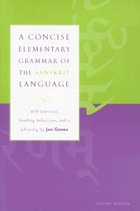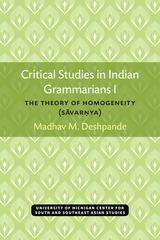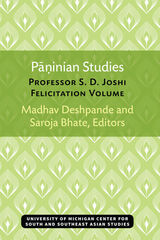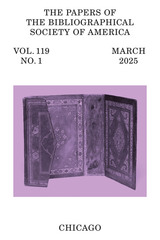4 books about Sanskrit language

A Concise Elementary Grammar of the Sanskrit Language
Jan Gonda
University of Alabama Press, 2006
A standard course book for students of linguistics.
[more]

Critical Studies in Indian Grammarians I
The Theory of Homogeneity (Savar?ya)
Madhav M. Deshpande
University of Michigan Press, 1975
In the historical study of the Indian grammarian tradition, a line of demarcation can often be drawn between the conformity of a system with the well-known grammar of Pāṇini and the explanatory effectiveness of that system. One element of Pāṇini’s grammar that scholars have sometimes struggled to bring across this line of demarcation is the theory of homogeneity, or sāvarṇya, which concerns the final consonants in Pāṇini’s reference catalog, as well as phonetic similarities between sounds. While modern Sanskrit scholars understand how to interpret and apply Pāṇini’s homogeneity, they still find it necessary to unravel the history of varying interpretations of the theory in subsequent grammars.
Madhav Deshpande’s The Theory of Homogeneity provides a thorough account of the historical development of the theory. Proceeding first to study this conception in the Pāṇinian tradition, Deshpande then passes on to other grammatical systems. Deshpande gives attention not only to the definitions of homogeneity in these systems but also the implementation of the theory in those respective systems. Even where definitions are identical, the concept may be applied quite differently, in which cases Deshpande examines by considering the historical relationships among the various systems.
[more]

Paninian Studies
Professor S. D. Joshi Felicitation Volume
Madhav Deshpande and Saroja Bhate, Editors
University of Michigan Press, 1991
Pāṇini’s grammar is the oldest surviving grammar of Sanskrit, dating back to the fifth century BCE. In its completeness of coverage of linguistic elements and its theoretical and analytical sophistication, Pāṇini’s grammar is surprisingly modern. It has long provided inspiration for many ideas in modern linguistics, and continues to attract scholars’ attention in the fields of Sanskrit and linguistics.
Pāṇinian Studies collects seventeen essays on Pāṇinian linguistics in a single volume dedicated to Professor S. D. Joshi, a stalwart scholar of Pāṇinian grammar. The contributors, all scholors of international acclaim and students and friends of Professor Joshi, include Ashok Aklujkar, Pandit V. B. Bhagwat, Saroja Bhate, Gopikamohan Bhattacharya, Johannes Bronkhorst, George Cardona, Achyutananda Dash, Madhav M. Deshpande, Peter Edwin Hook, Daniel H. H. Ingalls, V. N. Jha, Dinabandhu Kar, Paul Kiparsky, Bimal Krishna Matilal, G. B. Palsule, K. Kunjunni Raja, and J. A. F. Roodbergen. Taken together, their contributions encompass the wide range of interests and specializations within the field of Pāṇinian studies.
[more]

Samskrta-Subodhini
A Sanskrit Primer
Madhav M. Deshpande
University of Michigan Press, 1999
Saṃskṛta-Subodinī: A Sanskrit Primer marks the culmination of Professor Deshpande’s experience of teaching Sanskrit at the University of Michigan for over twenty-five years. Tested in classes at Michigan and elsewhere and successively improved for over twenty years, the teaching materials in the book now offer an effective tool to learn and teach Sanskrit. The focus is Sanskrit as a language, rather than as a religious or mystical entity. Deshpande’s primer also simplifies the process of learning Sanskrit by dissociating this language-learning process from the heavy burdens imposed both by the tradition of Indo-European linguistics and the tradition of indigenous Sanskrit grammarians in India. By treating Sanskrit as a productive language, rather than as a dead language merely to be deciphered, the book represents a significant advance over the traditional Western approach to the study of Sanskrit.
Work on this book began in 1976, and now almost two generations of Professor Deshpande's students have used successively improved versions. The book’s examples include many modified versions of classical Sanskrit passages from epic texts such as the Mahabharata and the Ramayana. The book also contains examples from Hindu, Buddhist, and Jain traditions, as well as samples of Sanskrit poetry and satire.
[more]
READERS
Browse our collection.
PUBLISHERS
See BiblioVault's publisher services.
STUDENT SERVICES
Files for college accessibility offices.
UChicago Accessibility Resources
home | accessibility | search | about | contact us
BiblioVault ® 2001 - 2025
The University of Chicago Press









